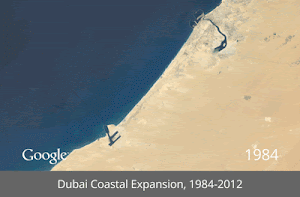Since the 1970s, NASA and the U.S. Geological Survey have been amassing satellite images of every inch of our planet as part of the Landsat program. Over time, the images reveal a record of change: of cities expanding, lakes and forests disappearing, new islands emerging from the sea off the coast of rising Middle East metropolises like Dubai.
If you could thumb through these historic pictures as if in a flip book, they would show stunning change across the earth's surface, in both our natural environments and our man-made ones. Now, the digital equivalent of that experience is possible – three decades of global change as a GIF – in a project between NASA, the USGS, TIME, Google, and the CREATE Lab at Carnegie Mellon University.
Landsat images taken between 1984 and 2012 have been converted into a seamless, navigable animation built from millions of satellite photos.
Follow the link to a few of the GIFs Google has created showing some of the most startling pockets of change - LINK
Wednesday, 23 October 2013
Tuesday, 22 October 2013
Changing of the guard
In a much less fanfare than the changing of the guards at Buckingham Palace three new state representatives have been appointed to replace the outgoing members who have completed their terms on the committee.
Here's the new line up:
Nav Sunner takes over from Alex Frankcombe in WA.
Harry Quartermain takes over from Michael Dixon in NSW.
Sara Vikstrom takes over from Claire Armstrong in TAS.
Tuesday, 8 October 2013
Placemaking is a sweat!
The 'Fat Jew' aka Fabrizio Goldstein teaches Bikram Yoga at the NYC Second Avenue F-train stop.
The New York subways are notoriously hot and many commuters consider riding the subway in August unbearable, a daily torture that has to be endured to get around the city. One man has used the puffs of hot air from the trains to his advantage and has transformed the underground into a Bikram Yoga Class for the homeless.
Comedian Fabrizio Goldstein, who also goes by the alias 'Fat Jew', is passing on his skills to the destitute, by helping them limber up during the sweaty classes.
More here - Link
The New York subways are notoriously hot and many commuters consider riding the subway in August unbearable, a daily torture that has to be endured to get around the city. One man has used the puffs of hot air from the trains to his advantage and has transformed the underground into a Bikram Yoga Class for the homeless.
Comedian Fabrizio Goldstein, who also goes by the alias 'Fat Jew', is passing on his skills to the destitute, by helping them limber up during the sweaty classes.
More here - Link
Wednesday, 2 October 2013
PIA calls for clarity on the future of Australian cities
THE Planning Institute of Australia (PIA) has called for clarity from the Federal Government on the future of Australian cities following the dismantling of the Major Cities Unit, which was established by the former Labor Government in 2008 to advice on issues of policy, planning and infrastructure that have an impact on cities.
Read more at Urbanalyst
Read more at Urbanalyst
Monday, 30 September 2013
LEGO Cities
So here I thought that LEGO was for kids! Apparently not the case, or at least it's for big kids. Like these:
Friday, 27 September 2013
Urban App of the Day: Compare Global Cities on the iPad
The free Urban World was developed by the McKinsey Global Institute, a research organization aimed at informing business and policy makers about the global economy. It stems from the institute's myriad research and data.
FourSquare check-ins show the pulse of cities
For years, the location-tracking app FourSquare has been amassing an enviable well of data on how people spend their time, where they go, and what these patterns reveal about their commuting and entertaining behaviors. If you're on one end of the app, checking in on your smart phone at a neighborhood dive bar, the tool is a handy way to broadcast your whereabouts to your friends. From the other end – from FourSquare's point of view – each logged location contributes to a much larger picture of the life of whole business districts and cities.
 |
| Foursquare check-ins show the pulse of New York City and Tokyo |
What Will Happen to Budapest's 'Ruin Pubs' Once All the Ruin Is Removed?
 |
| Szimpla in the Budapest Jewish Quarter |
You wouldn’t know it from the outside, but this is one of the most popular places to be in Budapest, at least on a Friday or Saturday night.
Push past the front door and a dimly-lit hallway leads to a large, open-air courtyard. Colorful lights strung together with furniture and a bicycle or two hang suspended in the air above and scenes from a black-and-white movie are projected onto the back wall. Off to the side sits an old Trabant, a type of car made in East Germany during the Cold War. The courtyard opens onto a maze of rooms, each decorated differently. In one, ancient-looking computer monitors and television sets are mounted to the walls. In another, a bathtub has been split in half and converted into a makeshift seating area.
Read more here
How to Design a City for Women
Don’t worry this is
not about separating the genders, or some post feminist ranty power grab.
In 1999, officials in Vienna, Austria, asked residents of the city's ninth district how often and why they used public transportation. "Most of the men filled out the questionnaire in less than five minutes," says Ursula Bauer, one of the city administrators tasked with carrying out the survey. "But the women couldn't stop writing."
The majority of men reported using either a car or public transit twice a day -- to go to work in the morning and come home at night. Women, on the other hand, used the city’s network of sidewalks, bus routes, subway lines and streetcars more frequently and for a myriad reasons.
"The women had a much more varied pattern of movement," Bauer recalls. "They were writing things like, 'I take my kids to the doctor some mornings, then bring them to school before I go to work. Later, I help my mother buy groceries and bring my kids home on the metro.'"
Women used public transit more often and made more trips on foot than men. They were also more likely to split their time between work and family commitments like taking care of children and elderly parents. Recognizing this, city planners drafted a plan to improve pedestrian mobility and access to public transit.
Read more at Atlantic Cities - Link
In 1999, officials in Vienna, Austria, asked residents of the city's ninth district how often and why they used public transportation. "Most of the men filled out the questionnaire in less than five minutes," says Ursula Bauer, one of the city administrators tasked with carrying out the survey. "But the women couldn't stop writing."
The majority of men reported using either a car or public transit twice a day -- to go to work in the morning and come home at night. Women, on the other hand, used the city’s network of sidewalks, bus routes, subway lines and streetcars more frequently and for a myriad reasons.
"The women had a much more varied pattern of movement," Bauer recalls. "They were writing things like, 'I take my kids to the doctor some mornings, then bring them to school before I go to work. Later, I help my mother buy groceries and bring my kids home on the metro.'"
Women used public transit more often and made more trips on foot than men. They were also more likely to split their time between work and family commitments like taking care of children and elderly parents. Recognizing this, city planners drafted a plan to improve pedestrian mobility and access to public transit.
Read more at Atlantic Cities - Link
Subscribe to:
Posts (Atom)






